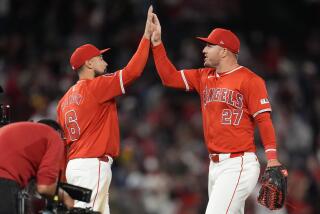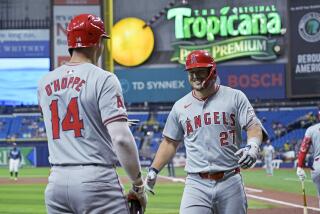Angel Fans Recognize a Bad Team
- Share via
If there was such a thing as truth in advertising at Anaheim Stadium, the theme for this afternoon’s Angel season finale would be Fan Depreciation Day.
As you may have noticed, the number of fans has been depreciating all year.
Having watched too many Angel teams give up during the past three decades, Angel fans finally did likewise in 1992.
They finally stopped coming to pay.
Attendance is down nearly 375,000 from last year, the sharpest season-to-season decrease in the history of the franchise. And excluding the strike year of 1981, the Angels are going to draw fewer than 2.1 million for the first time since 1978.
In these last few existential weeks--Does an Angel game in September have any meaning?--the stands have begun to resemble Anaheim Stadium during the Ryan years, on the days Ryan wasn’t pitching. Thursday afternoon, the day after the George Brett 3,000 blowout, the crowd count was fewer than 17,000--a 14-year low--and that was counting 8,000 or so season-ticket holders who didn’t show.
For one day, the Big A became California’s largest diamond lane. A pair there, and a pair there . . .
Who can blame the fans? Come out and watch the Angels? What’s the point, what’s the incentive?
To study the flight of Gary Gaetti’s batting average and pretend it’s the neon ball that drops at Times Square on New Year’s Eve?
To follow 36-year-old Ken Oberkfell’s quest to outhit the entire Angel youth movement? At .258, Creakin’ Ken only has Chad Curtis (.259) and Damion Easley (.260) to catch.
To sit and ponder what yet-to-retire former Angel’s number will be painted on the right-field wall next year? Dante Bichette’s 19? Mike Fetters’ 48? Dave Winfield’s 32?
Old Angels never die, they just go on to the American League East pennant race.
And what have Jackie Autry’s front office troops done to get those turnstiles turning again?
They fired radio announcers Al Conin and Bob Jamison for too much negative reporting. They didn’t like the way Conin and Jamison closed most of their broadcasts with the phrase, “Angels lose.”
They unveiled a new logo for 1993, to be followed by new uniforms. The design is actually a throwback to the one worn by the Angels in the late 1960s, to match the won-lost records of the respective eras. In 1968 and 1969, the Angels also lost more than 90 games.
And they have floated the vague promise/threat of a “big trade” that will almost certainly include Jim Abbott, the only marketable face and marquee name left on the roster.
Big Angel trades scare me. The last good one the team made was Fregosi-for-Ryan.
The last bad one? Does Kyle Abbott and Ruben Amaro for Von Hayes ring a bell?
Buck Rodgers, searching for a silver lining to wrap around this package from the dead letter office, notes that “We had a tremendous developmental year. Almost everybody we brought up--and we brought up a lot--showed they could cut it in the major leagues.”
Rodgers proceeds to tick off the list.
“The jury’s still out on (Tim) Salmon, but Easley, (Gary) DiSarcina, Joe Grahe moving from starter to reliever, Curtis, (John) Orton, Scotty Lewis, Julio Valera--all these kids showed they belonged.”
Rodgers makes one point that is difficult to dispute: the Angels of October have a more interesting look than the Angels of April. Then again, so did the Seattle Pilots of 1969, but in Anaheim, you take progress wherever you can find it.
Any Angel move away from crotchety underachievement to youthful enthusiasm is a step in the right direction. But this ballyhooed Angel youth movement has happened more by accident than by any grand design or vision. Rather, it was forced upon Rodgers when absolutely, positively none of Whitey Herzog’s winter transactions amounted to more than a pile of pink slips.
Whitey went 0-for-the-off-season.
Von Hayes is out of baseball.
Hubie Brooks is headed there soon.
Alvin Davis is in Japan.
Chuck Crim has an earned-run average of 5.23, or about four runs higher than the man Herzog traded for him, Fetters.
Whitey rallied a little with the Valera-for-Dick Schofield deal in April, but you will notice that the Angels’ relative upturn the last two months has coincided with no trades by Whitey the last two months.
Alas, the Angels will probably need to trade again, because Jackie Autry has sworn off free agents and the Angels have a gaping hole to fill at first base. Even Rodgers will concede that Lee Stevens “was probably the only young guy who showed he couldn’t cut it.”
Rodgers wants “a left-handed hitter in the middle of the lineup who can drive in runs. Maybe two.” Designated hitter and center field are next on Rodgers’ wish list, since the Angels have seen where Junior Felix-in-center will take them--sixth place--and believe Curtis’ future is in left field.
After that, Rodgers could use some pitching depth. “Basically, we have a staff where a 41-year-old man is our fifth starter,” he says, referring to Bert Blyleven. “A 41-year-old man who is not a knuckleballer or Nolan Ryan.”
But with Curtis in left, Salmon in right, DiSarcina at shortstop and Easley at second base, winter experiment willing, Rodgers believes that the Angels, for the first time in a long time, are heading into the future with, well, a future.
“We gave chances to a lot of players and they’ve taken the first step,” Rodgers says. “The next step is to see if no one falls on their faces.”
And to see if anyone out there notices.
More to Read
Go beyond the scoreboard
Get the latest on L.A.'s teams in the daily Sports Report newsletter.
You may occasionally receive promotional content from the Los Angeles Times.






